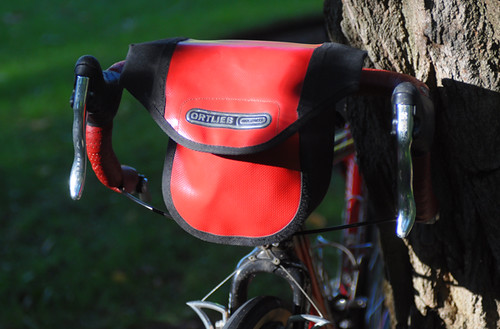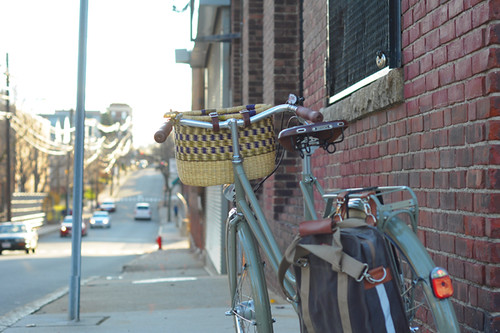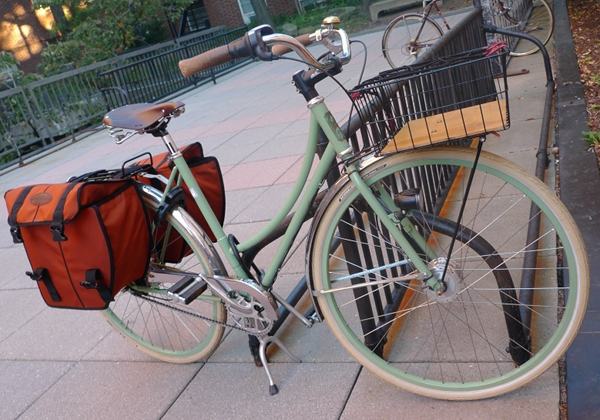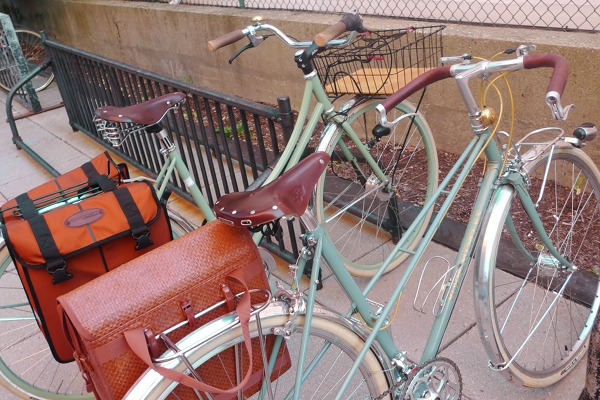
I get a lot of reader questions about front bags, and particularly about whether I've found a good way to carry a bag on the handlebars without using additional support. Short answer: In my experience, it depends on the bike, on how much weight is being carried, and on how the bag is attached to the bars. These factors interact with varied results.

On roadbikes, I have tried carrying unsupported loads on the handlebars using several methods. Bags attached with straps are appealing, because they do not require permanent hardware installation. However, on longer and/or faster rides I find it difficult to keep them from sliding along the handlebars, no matter how tight the straps and how light the load. If the bag slides when I lean on a turn at high speed, it feels distracting and disconcerting, even if it is too light to affect steering.
A few manufacturers have come up with hardware to address this, including the Nitto Bar Sack Rack, the Brooks Cornwall system, andthe Rixen & Kaul KlickFix adapter. The latter I've had a chance to investigate on Pamela Blalock's bikes - who uses it on most of her roadbikes.

TheKlickFix adapter is mounted on the handlebars and remains there when the bag is detached. It is compatible with many bags from different manufacturers, the most popular being the waterproof Ortlieb bags, available in a variety of sizes. This is a very stable system for carrying unsupported weight on the handlebars, and it worked for me with light loads: I felt zero movement. However, when I added my DSLR camera (between 2 and 3lb with lens), I found that I had poor control of the steering. I reported this to the bag's owner, who confirmed that she does not carry that much weight in a handlebar bag on this or on any of her other roadbikes; she uses this system to store lightweight items only.
Of course, it is not clear whether having the weight lower and supported by a rear rack would make any difference on the specific bike I rode. Anecdotal evidence suggests that it very well could. On the other hand, I have seen touring bikes with large, heavily laden bags attached to the bars using this same method, ridden successfully. So the bike does play a role, as, no doubt, does rider sensitivity to high/ unsupported loads.

With upright city bikes - especially heavily built ones - there is generally more tolerance. I have ridden such bikes with all manner of baskets and bags attached to the handlebars without lower support, and for short distances it's been fine if the weight is only a few pounds. I've even managed to attach my Po Campo pannierto the handebars of a Raleigh DL-1, and ride with this setup with 5lb+ of weight in the bag. The bag does slide side to side and affects steering a bit, but since I am not riding fast or cornering aggressively, it doesn't bother me. The heavier the load, the more likely it is to become problematic. And then again, there are those who simply hang heavy shopping bags off their handlebarsand blithely pedal away.
The general consensus is that carrying weight high on the handlebars and without additional lower support is not ideal. A stable system such as the R&K KlickFix adaptor is probably your best bet, but still there are limits to how much weight will feel comfortable.If you have a success story, do share.Personally, in the absence of a front rack, I prefer to carry weight at the rear of the bike.

 The road now a river
The road now a river The work of beavers
The work of beavers View from the bridge
View from the bridge Largest trillium I have ever seen
Largest trillium I have ever seen Needle carpeted trail
Needle carpeted trail

 On Friday May 14, the U.S. Senate unanimously passed Resolution 526, which honors the men and women who perform Search and Rescue (SAR) throughout the United States. The Resolution specifically acknowledges the role that professionals and volunteers provide to our country, and sets aside the week of May 16 to May 22, as National Search and Rescue week. Also, it encourages the people of the United States to observe and hold ceremonies and activities that promote awareness and appreciation of the role SAR personnel provide for their communities.
On Friday May 14, the U.S. Senate unanimously passed Resolution 526, which honors the men and women who perform Search and Rescue (SAR) throughout the United States. The Resolution specifically acknowledges the role that professionals and volunteers provide to our country, and sets aside the week of May 16 to May 22, as National Search and Rescue week. Also, it encourages the people of the United States to observe and hold ceremonies and activities that promote awareness and appreciation of the role SAR personnel provide for their communities.

 On a lovely Sunday afternoon in Boston, my Royal H. mixte ran into a cousin...an ANTLady's Boston Roadster of the same colour.
On a lovely Sunday afternoon in Boston, my Royal H. mixte ran into a cousin...an ANTLady's Boston Roadster of the same colour. I promise the ANT is not mine. But whoever it was built for certainly has a similar taste in bicycles.
I promise the ANT is not mine. But whoever it was built for certainly has a similar taste in bicycles. Sage green loop frame, cream Delta Cruiser tires, brown leather saddle, cork grips and huge copper panniers - I think the combination looks great. And notice that the rims are powdercoated the same colour as the frame.
Sage green loop frame, cream Delta Cruiser tires, brown leather saddle, cork grips and huge copper panniers - I think the combination looks great. And notice that the rims are powdercoated the same colour as the frame. It's fairly accurate to say that my Royal H. and this ANT are related. Not only because both were made by Bostonian frame builders and have similar "complexions," but also because some time ago Mike Flanigan (of ANT) gave Bryan Hollingsworth (of Royal H.) the new-old-stock mixte lugs that made the construction of my bicycle possible.
It's fairly accurate to say that my Royal H. and this ANT are related. Not only because both were made by Bostonian frame builders and have similar "complexions," but also because some time ago Mike Flanigan (of ANT) gave Bryan Hollingsworth (of Royal H.) the new-old-stock mixte lugs that made the construction of my bicycle possible. Like my mixte, the ANT roadster was built with racks and dynamo lighting. Looking at the "cycling landscape" in Boston today, I think it is important to credit ANT for resurrecting the notion that transport bikes should be built with these features. I see more and more bicycles now with dynamo lighting, whereas as recently as a year ago people would stop and ask me why my front hub was so large, amazed when I would explain that the lights are powered by pedaling. And racks are now pretty much the norm on city bicycles, whereas a year or two ago they were an anomaly. ANTbikes, and the younger local builders whose work is influenced by them, played a crucial role in this change.
Like my mixte, the ANT roadster was built with racks and dynamo lighting. Looking at the "cycling landscape" in Boston today, I think it is important to credit ANT for resurrecting the notion that transport bikes should be built with these features. I see more and more bicycles now with dynamo lighting, whereas as recently as a year ago people would stop and ask me why my front hub was so large, amazed when I would explain that the lights are powered by pedaling. And racks are now pretty much the norm on city bicycles, whereas a year or two ago they were an anomaly. ANTbikes, and the younger local builders whose work is influenced by them, played a crucial role in this change. It is nice to live in a city that is home to so many excellent frame builders, and to spontaneously "meet" other local handbuilt bicycles. The bike pictured here was actually the second ANTI saw today. Earlier, I was stopped at an intersection and heard the cyclist behind me say "Sick bike! Where did you get it?" I started telling him aboutRoyal H. and handbuilt frames, then realised that he was riding a blackANT when he pulled up beside me. "Hey, yours is an ANT!" What a weird thing to bond over, bicycles. Encounters like these make me feel like a character out of a 1950s sitcom, where neighbours wave and smile to one another and the mailman whistles a happy tune.
It is nice to live in a city that is home to so many excellent frame builders, and to spontaneously "meet" other local handbuilt bicycles. The bike pictured here was actually the second ANTI saw today. Earlier, I was stopped at an intersection and heard the cyclist behind me say "Sick bike! Where did you get it?" I started telling him aboutRoyal H. and handbuilt frames, then realised that he was riding a blackANT when he pulled up beside me. "Hey, yours is an ANT!" What a weird thing to bond over, bicycles. Encounters like these make me feel like a character out of a 1950s sitcom, where neighbours wave and smile to one another and the mailman whistles a happy tune.










 The sixth photo in the sixth folder of the sixth folder of my "Image Files" folder was taken at my grandpa's house in December 1954 and my sister Terry was just learning to walk. Mom has always said "It was her first step" but who knows. A rather appropriate picture though, seeing as how today (January 31st) is her birthday. . .
The sixth photo in the sixth folder of the sixth folder of my "Image Files" folder was taken at my grandpa's house in December 1954 and my sister Terry was just learning to walk. Mom has always said "It was her first step" but who knows. A rather appropriate picture though, seeing as how today (January 31st) is her birthday. . .
















 In this shot you can see the logs that were part of the log cabin and an old rusted out Model T truck that was near the cabin.
In this shot you can see the logs that were part of the log cabin and an old rusted out Model T truck that was near the cabin.